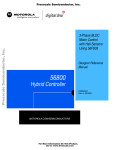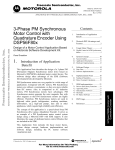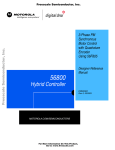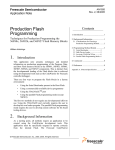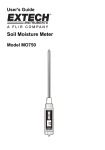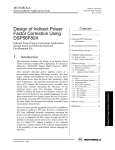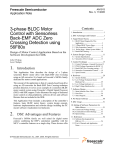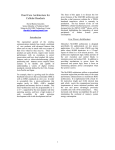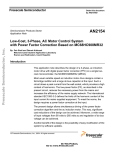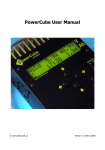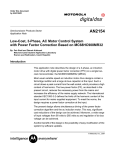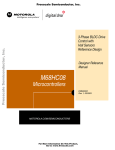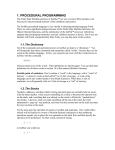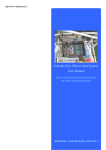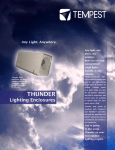Download AN1916 Application Note
Transcript
MOTOROLA Order by AN1916/D (Motorola Order Number) Rev. 0, 6/01 Semiconductor Application Note 3-Phase BLDC Motor Control with Hall Sensors Using DSP56F80x Design of Motor Control Application Based on Motorola Software Development Kit Contents 1. Introduction of Application Benefit 1 2. Motorola DSP Advantages and Features .....................................1 3. Target Motor Theory ......................3 Pavel Grasblum 4. System Concept.............................. 4 Introduction of Application Benefit This Application Note describes a design of a 3-phase BLDC (Brushless DC) motor drive based on Motorola’s DSP56F80x dedicated motor control device. The software design takes advantage of the SDK (Software Development Kit) developed by Motorola. The concept of the application is a speed closed loop BLDC drive using a position Hall Sensor. It serves as an example of a BLDC motor control system design using a Motorola DSP with SDK support. It also illustrates the usage of dedicated motor control libraries that are included in the SDK. This Application Note includes the basic motor theory, system design concept, hardware implementation and software design, including the PC Master visualization tool. 2. Motorola DSP Advantages and Features The Motorola DSP56F80x family is well suited for digital motor control, combining the DSP’s calculation capability with the MCU’s controller features on a single chip. These DSPs offer many dedicated peripherals like Pulse Width Modulation (PWM) module, Analog-to-Digital Converter (ADC), Timers, communication peripherals (SCI, SPI, CAN), on-board Flash and RAM. Generally, all family members are well suited for various motor controls. The typical member of the family, the DSP56F805, provides the following peripheral blocks: © Motorola, Inc., 2001 5. Hardware Design ............................9 6. Software Design ...........................10 6.1 6.2 6.3 6.4 6.5 6.6 Data Flow ......................................10 Application State Diagram............11 Drive State Machine......................13 Routines Description.....................13 Implementation Notes ...................17 Communication with PC Master...17 7. PC Master .....................................18 8. DSP Usage ...................................18 9. References ....................................19 3-Phase BLDC Motor Control with Hall Sensors 1. 4.1 Control Technique...........................6 Motorola DSP Advantages and Features • Two Pulse Width Modulator modules (PWMA & PWMB), each with six PWM outputs, three Current Sense inputs, and four Fault inputs, fault tolerant design with deadtime insertion, supporting both Center- and Edge- aligned modes • Twelve bit Analog to Digital Convertors (ADCs), supporting two simultaneous conversions with dual 4-pin multiplexed inputs; ADC can be synchronized by PWM modules • Two Quadrature Decoders (Quad Dec0 & Quad Dec1), each with four inputs, or two additional Quad Timers A & B • Two dedicated General Purpose Quad Timers totaling 6 pins: Timer C with 2 pins and Timer D with 4 pins • CAN 2.0 A/B Module with 2-pin ports used to transmit and receive • Two Serial Communication Interfaces (SCI0 & SCI1), each with two pins, or four additional GPIO lines • Serial Peripheral Interface (SPI), with configurable 4-pin port, or four additional GPIO lines • Computer Operating Properly (COP) timer • Two dedicated external interrupt pins • Fourteen dedicated General Purpose I/O (GPIO) pins, 18 multiplexed GPIO pins • External reset pin for hardware reset • JTAG/On-Chip Emulation (OnCE) • Software-programmable, Phase Lock Loop-based frequency synthesizer for the DSP core clock Table 2-1. Memory Configuration DSP56F801 DSP56F803 DSP56F805 DSP56F807 Program Flash 8188 x 16-bit 32252 x 16-bit 32252 x 16-bit 61436 x 16-bit Data Flash 2K x 16-bit 4K x 16-bit 4K x 16-bit 8K x 16-bit Program RAM 1K x 16-bit 512 x 16-bit 512 x 16-bit 2K x 16-bit Data RAM 1K x 16-bit 2K x 16-bit 2K x 16-bit 4K x 16-bit Boot Flash 2K x 16-bit 2K x 16-bit 2K x16-bit 2K x 16-bit Other than the fast Analog-to-Digital converter and the 16-bit Quadrature Timers, the most interesting peripheral from the BLDC motor control point of view is the Pulse Width Modulation (PWM) module. Its configuration provides the freedom to efficiently control the BLDC motor. The PWM has the following features: 2 • Three complementary PWM signal pairs, or six independent PWM signals • Features of complementary channel operation • Deadtime insertion • Separate top and bottom pulse width correction via current status inputs or software • Separate top and bottom polarity control • Edge-aligned or center-aligned PWM signals • 15-bits of resolution • Half-cycle reload capability 3-Phase BLDC Motor Control with Hall Sensors Target Motor Theory • Integral reload rates from one to 16 • Individual software-controlled PWM outputs • Mask and Swap of PWM outputs • Programmable fault protection • Polarity control • 20-mA current sink capability on PWM pins • Write-protectable registers The BLDC motor control utilizes the PWM block set in the complementary PWM mode to generate control signals for all switches of the power stage with deadtime generation. The PWM outputs can be controlled separately by software which can set the control signal to logical 0 or 1. One feature which is very useful for BLDC motor control is the channel swap function. The state of the control signals can be changed immediately when required by the motor position (phase commutation) without changing the content of the PWM value registers. These changes can be accomplished asynchronously to the PWM duty cycle update. 3. Target Motor Theory A brushless DC (BLDC) motor is a rotating electric machine where the stator is a classic three phase stator like that of an induction motor and the rotor has surface-mounted permanent magnets (see Figure 3-1). Stator Stator winding (in slots) Shaft Rotor Air gap Permanent magnets Figure 3-1. BLDC Motor - Cross Section In this respect the BLDC motor is equivalent to an inverted DC commutator motor, in that the magnet rotates while the conductors remain stationary. In the DC commutator motor, the current polarity is reversed by the commutator and brushes, but in the brushless DC motor, the polarity reversal is performed by a power transistor which must be switched in synchronization with the rotor position. Therefore, the BLDC motor often has either internal or external position sensors to sense actual rotor position. 3-Phase BLDC Motor Control with Hall Sensors 3 System Concept The presented application uses three Hall Sensors to sense actual position. The Hall Sensors’ signals together give the six output values. These outputs are read by DSP and the corresponding output voltage is generated by PWM outputs (see Figure 3-2). Phase Magnetic Flux Linkage 3VLB$ 3VLB% 3VLB& Ph. A Ph. B Ph. C Ph. B $WRS %WRS &WRS &ERW $ERW 8LB$ Phase Back EMF Ph. A 8LB% 8LB& Speed reversal Ph. C %ERW Acting power switch in the power stage Phase-Phase Back EMF A-B 8LB$% 8LB$% 8LB%& 8LB%& 8LB&$ 8LB&$ B-C C-A 3RVB$ Phase C Hall Sensor outputs 3RVB% 3RVB& Phase B ABC [101] Phase A Figure 3-2. BLDC Motor - Back EMF and Mag. Flux, Hall Sensor Outputs 4. System Concept The system is designed to drive a 3-phase BLDC motor. The DSP runs the main control algorithm. According to the user interface input and feedback signals, it generates 3-phase PWM output signals for the motor inverter. 4 3-Phase BLDC Motor Control with Hall Sensors System Concept A standard system concept is chosen for the drive (see Figure 4-1). The system incorporates the following hardware boards: • Power Supply 12V DC, 4Amps • EVM Motor Board • BLDC Motor IB23810 • Evaluation Board DSP56F803 or DSP56F805 DSP56F80x EVM 12V DC DSP56F80x PWM1-6 PC Master R S 2 3 2 P W M Speed Calculation PI Controller Commutation Handler START STOP UP G P I O ±ΩReq DOWN EVM Motor Board T I M E R D E C O D E R Hall Sensors BLDC motor Figure 4-1. System Concept The control process is as follows: The state of the inputs is periodically scanned, while the speed of the motor is measured on each new coming edge from Hall Sensors. According to the state of the control signals (Start/Stop switch, speed up/down buttons) the speed command is calculated. The comparison between the actual speed command and the measured speed generates a speed error. The speed error is brought to the speed PI controller that generates a new corrected applied voltage. The Hall Sensor signals are scanned independently on speed control. Each new coming edge of any Hall Sensor signal calls the interrupt routine which calculates new voltage shape applied to the BLDC motor. This process is called commutation. The PWM transistors work in complementary mode. Undervoltage protection of the DC Bus is measured during the control process and is performed by software. 3-Phase BLDC Motor Control with Hall Sensors 5 System Concept 4.1 Control Technique The brushless DC motor (BLDC motor) is also known as an electronically commuted motor. There are no brushes on the rotor and the commutation is performed electronically at certain rotor positions. The three phase voltage system (see Figure 4-2) with a rectangular shape is used to create a rotational torque. This easily created shape of applied voltage ensures the simplicity of control of drive. The rotor position must be known in order to align energized phases with the rotor’s permanent magnetic field. The alignment is very important because it results in proper commutation in the PWM inverter where the voltage level is reduced by chopping. In this condition the motor behaves as a DC motor and runs at the best working point. The simplicity of control and good performance makes this motor a natural choice for low-cost and high-efficiency applications. There are many methods how to provide alignment between back EMF and commutation events. The presented application use Hall Sensors to sense the commutation events. electrical angle Figure 4-2. Three phase voltage system applied to BLDC motor 4.1.1 Commutation Algorithm The commutation algorithm provides the generation of a rotational field according to rotor position. This algorithm uses the Hall Sensors to obtain the rotor position. The Hall sensors outputs are connected to Quadrature decoder input pins. The input pins go through the digital filter to three quadrature timers. The timers are set to catch each edge of input signals and call interrupt routine which provide commutation algorithm. The Hall Sensor consists of three sensors (Sensor A, Sensor B, Sensor C). These sensors comprise six states (001, 010, 011, 100, 101, 110). Each state determines which phases should be powered by the 3-phase inverter. The interrupt routine reads the state of Hall Sensors from Input Monitor Register (IMR) of quadrature decoder. This value is used as pointer to the commutation table (Table 4-1, Table 4-2), which includes information about masking and swapping of power transistors. The resultant voltage applied to BLDC motor per one electrical revolution is shown on Figure 4-2. 6 3-Phase BLDC Motor Control with Hall Sensors System Concept Table 4-1. Commutation Sequence for Clockwise Rotation +DOO6HQVRU$ +DOO6HQVRU% +DOO6HQVRU& 3KDVH$ 3KDVH% 3KDVH& 9'&% 9'&% 1& 9'&% 1& 9 '&% 1& 9 '&% 9 '&% 9 '&% 9 '&% 1& 9 '&% 1& 9'&% 1& 9'&% 9'&% Table 4-2. Commutation Sequence for Counterclockwise Rotation +DOO6HQVRU$ +DOO6HQVRU% +DOO6HQVRU& 3KDVH$ 9'&% 3KDVH% 9'&% 3KDVH& 1& 1& 9'&% 9'&% 9'&% 1& 9'&% 9'&% 9'&% 1& 9'&% 1& 9'&% 9'&% 9'&% 1& Start of New Edge Interrupt Read new state of Hall Sensors Look up new swap and mask values in the table Put new value to PWM module RTI Figure 4-3. Commutation Algorithm for Hall Sensors 3-Phase BLDC Motor Control with Hall Sensors 7 System Concept The generation of the PWM voltage waveforms is done by using of masking and swapping without changing of the PWM Value Register (duty cycle). This method allows independence of commutation and speed control. Figure 4-4 shows the generated voltage waveforms for Hall Sensors state A=0, B=1, C=0 at clockwise direction. The phase A is masked (disabled). The voltage polarity of phase C is changed by swapping of upper and bottom transistor. The resulting voltage applied on the motor is UBC. The Value Registers of all PWM outputs remain unchanged. A B 70% 0% 1. 0% 3. 30% 2. 4. C 70% 30% 5. 30% 70% 6. SWAP Figure 4-4. Voltage Waveforms for the Hall Sensors State A = 0, B = 1, C = 0, Clockwise Direction Warning: For the 56F80x revision B the mask feature works properly in the independent mode. Therefore it is necessary to use software control to implement the mask feature in the complementary mode. 4.1.2 Speed Control The speed of BLDC motor is controlled by amplitude of applied voltage. The amplitude of applied voltage is regulated by pulse-width modulation (PWM). The main advantage of the described application is the independence of the commutation algorithm and the speed control algorithm. 8 3-Phase BLDC Motor Control with Hall Sensors Hardware Design 5. Hardware Design The motor control system is designed to drive the 3-phase BLDC motor in a speed closed loop on EVM Motor Board (ECMTREVAL). The system configuration is shown in Figure 5-1. ZIODW 8 *1' - 9'& ULEERQ FDEOH (YDOXDWLRQ 0RWRU %RDUG 8 &RQWUROOHU%RDUG - '63)[(90 - +DOO6HQVRU&RQQ7DEOH 0RWRU &RQWUROOHU (&075(9$/ 0 &RQQ '63) - '63) - '63) - 81,&RQQHFWRUV7DEOH &RQWUROOHU IB23810 +DOO6HQVRUV&DEOH &RQQ '63) 3 '63) - '63) - Figure 5-1. Low Voltage Evaluation Motor HW System Configuration The detailed setup including jumper settings can be found in the document Embedded SDK (Software Development Kit) Targeting Motorola DSP5680X Platform (where X means 3 or 5). All the system parts are supplied and documented according the following references: • M1 - IB23810 Motor — supplied in kit ECMTREVAL - Evaluation Motor Board Kit • U2 EVM Motor Board: — supplied in kit with IB23810 Motor: ECMTREVAL - Evaluation Motor Board Kit — described in: Evaluation Motor Board User’s Manual • U1 CONTROLLER BOARD for DSP56F805: — supplied as: DSP56805EVM — described in: DSP Evaluation Module Hardware User’s Manual • or U1 CONTROLLER BOARD for DSP56F803: — supplied as: DSP56803EVM — described in: DSP Evaluation Module Hardware User’s Manual The detailed description of individual boards can be found in comprehensive User’s Manuals belonging to each board or on http://mot-sps.com/motor/devtools/index.html. The user’s manual incorporates the schematic of the board, descriptions of individual function blocks and bill of materials. The individual boards can be ordered from Motorola as a standard product. 3-Phase BLDC Motor Control with Hall Sensors 9 Software Design 6. Software Design This section describes the design of the software blocks of the drive. The software will be described in terms of: • Control Algorithm Data Flow • State Transition 6.1 Data Flow The control algorithm of a close loop BLDC drive is described in Figure 6-1. It consists of processes described in the following sections. SCI Communication Process SCI POSITION SENSOR (Hall Sensors) SPEED SETTING by BUTTONS Latest Position Capture Period omega_required_mech Measuring omega_desired_mech MeasuredTime DirectionSpinning EncoderState Velocity Calculation Speed Controller (PI Controller) omega_actual_mech DC_Bus Voltage (A/D Converter) Mask and Swap Calculation u_dc_bus DesVoltage PWMState Software Block PWM Generation Hardware Block Figure 6-1. Main Data Flow 10 3-Phase BLDC Motor Control with Hall Sensors Software Design 6.1.1 Processes Latest Position Capture, Period Measuring and Velocity Calculation The Latest Position Capture, Period Measuring and Velocity Calculation processes relate to the inputs of the Hall Sensors. The sensors generate streams of pulses that are captured (separately for each sensor) by the Input Capture (IC) function. The process Latest Position Capture captures the latest state of Hall Sensors. The processes Period Measuring and Velocity Calculation read the time between the adjacent rising edges of Hall sensor output and calculates the actual motor speed omega_actual_mech. 6.1.2 Process Speed Controller The process calculates the duty cycle of the PWM based on the output of the speed controller (the PI controller). 6.1.3 Process Mask and Swap Calculation The process calculates which PWM channel is enabled for PWM generation and which phase is swapped. 6.2 Application State Diagram Reset Initialization Interrupts Main loop (State Machine) Figure 6-2. Application State Diagram As Figure 6-2 shows, the application state consists of the initialization routine, followed by main loop with background tasks. The time critical functions are calculated by the interrupt routines. 3-Phase BLDC Motor Control with Hall Sensors 11 Software Design The brief description of the 3-ph BLDC motor control follows: • Initialization Routine (entered after RESET): — ADC initialization — System Timer for LED initialization — PWM initialization — IRQA and IRQB interrupt initialization — Quadrature timers A0, A1, A2 and their interrupt initialization — Quadrature decoder initialization — getting of initial motor position — setting of PI controller parameters — quadrature timer A3 initialization for speed measuring • Main Loop — Application state machine — - check of START/STOP switch state — - check of DC bus voltage • System Timer Interrupt Handler — UP/DOWN buttons filter — LED blinking and lighting — DC bus voltage measuring — Speed calculation — Speed PI controller calculation — setting of new duty cycle to PWM • IRQA Interrupt Handler — decrement required speed • IRQB Interrupt Handler — increment required speed • IC (Input Capture) Interrupt Handler (QTimers A0, A1, A2) — reading of encoder state — spin direction calculation — mask and swap of PWM transistors calculation — setting of new mask and swap to PWM • Timer Overflow Interrupt Handler (QTimer A3) for speed measuring — Increment overload counter • IC (Input Capture) Interrupt Handler (QTimer A3) for speed measuring — calculation of non-scaled period of one Hall Sensor channel • SCI (Serial Communication Interface) — Communication with PC Master 12 3-Phase BLDC Motor Control with Hall Sensors Software Design 6.3 Drive State Machine The drive can be in one of the following states as shown in Figure 6-3, which also shows transition conditions among the drive states. SwitchState=START Reset Init State SwitchState=STOP SwitchState=STOP OR u_dc_bus<MIN_DC_BUS_VOLTAGE Stopped State Running State SwitchState=START AND u_dc_bus>=MIN_DC_BUS_VOLTAGE Figure 6-3. Drive State Machine Transitions 6.4 Routines Description 6.4.1 LedISR(void) This interrupt routine is called periodically by timer which is set by function LedInit. This routine executes following functions: • LED blinking according to application mode (START/STOP). The period of blinking is given by LED_ISR_COUNT_VALUE x timer period (20 ms) • Reading of new sample of DC Bus Voltage and starting of new conversion • Scaling of measured period of one Hall Sensor channel • Speed calculation 3-Phase BLDC Motor Control with Hall Sensors 13 Software Design The constant OMEGA_ACTUAL_MECH_CONST is given by following equations: position difference = 1/4 rev (given by each edge of one Hall Sensor phase and two pole pairs motor) max. period time = 0.2 s (chosen according to required min. speed) vmin = 60*(position difference)/(max. period time) = 75 rpm vmax = 20*vmin = 1500 rpm (chosen according to required max. speed) OMEGA_ACTUAL_MECH_CONST = 32767*vmin/vmax = 1638 • Calculation of new duty cycle (by PI controller) • Setting of new duty cycle 6.4.2 ISRQTimer(void) This interrupt routine is called on each edge which is captured on the timers’ input. The timers A0, A1, A2 call the same interrupt routine. This routine executes following functions: • Reading of new Hall Sensors’ state • Calculation of spin direction • Calculation of transistors mask and swap • Set of transistors mask and swap 6.4.3 Word 16 DirectionCalculation(Word16 EncoderState, Word16 *NextEncoderState) Parameters: Word16 EncoderState - Input Actual state of Hall sensors Word16 *NextEncoderState - Input/Output pointer to expected state of Hall Sensors The function returns a value of 1 or -1 according to spin direction. 6.4.4 LedInit(void) This function is called during initialization only and sets system timer with period 20 ms. The system timer calls an interrupt routine named LedISR. 6.4.5 IncrementVariable (int *Variable, int Increment, int Limit) The function increments the variable pointed to by VARIABLE by Increment up to Limit. 6.4.6 DecrementVariable (int *Variable, int Decrement, int Limit) The function decrements the variable pointed to by VARIABLE. 14 3-Phase BLDC Motor Control with Hall Sensors Software Design 6.4.7 UpButtonISR(void) The interrupt function is called when the UP push button is pushed. The function increments variable omega_required_mech by speed_increment up to speed_up_limit. If omega_required_mech is equal to zero the omega_required_mech is directly set to minimal speed speed_400rpm 6.4.8 DownButtonISR(void) The interrupt function is called when the DOWN push button is pushed. The function decrements variable omega_required_mech by speed_increment up to speed_down_limit.. If omega_required_mech is equal to zero the omega_required_mech is directly set to minimal speed -speed_400rpm 6.4.9 ApplicationStateMachine(void) SwitchState=START Reset Init State SwitchState=STOP Stopped State SwitchState=STOP OR u_dc_bus<MIN_DC_BUS_VOLTAGE Running State SwitchState=STARTAND u_dc_bus>=MIN_DC_BUS_VOLTAGE Figure 6-4. Drive State Machine Transitions 6.4.9.1 Init State After RESET the application state of the machine goes directly to Init State. The omega_required_mech and omega_desired_mech are set to zero. If the START/STOP switch is in START position the machine state remains in Init State till the START/STOP switch is switched to STOP position. Then the machine state continues to be Stopped State. 3-Phase BLDC Motor Control with Hall Sensors 15 Software Design 6.4.9.2 Stopped State The omega_required_mech and omega_desired_mech are set to zero. The drive is stopped. If the START/STOP switch is switched to START position and DC Bus Voltage (U_DC_BUS) is greater or equal to min_DC_bus_voltage the machine state goes to Running State. 6.4.9.3 Running State The drive is running. The omega_required_mech is set by UP/DOWN push buttons or by PC Master. If required speed is less than speed_400rpm the omega_required_mech is set to zero. If START/STOP switch is switched to STOP position or the DC bus voltage is less than min_DC_bus_voltage the machine state goes to Stopped State. Each calling of the machine state enables or disables PWM outputs according to variable omega_required_mech. 6.4.10 Initialize(void) The function is called directly after RESET only. The function initializes the following blocks of the DSP: • ADC initialization • System Timer for LED initialization • PWM initialization • IRQA and IRQB interrupt initialization • Quadrature timers A0, A1, A2 and their interrupts initialization • Quadrature decoder initialization • Setting of initial motor position • Setting of PI controller parameters • Quadrature timer A3 and its interrupt initialization for speed measuring 6.4.11 Main(void) The function calls the Initialize function and then ApplicationStateMachine inside an endless loop. 6.4.12 StartMeasure(...) Parameters: unsigned long mksPeriodRange - Input max. measured period in us const char *timer_device_name - Input pointer to timer name qt_eSecondaryInputSource secondaryInputSource - Input secondary input source for timer 16 3-Phase BLDC Motor Control with Hall Sensors Software Design int decoderMode not used The function is called during initialization. The function configures the timer for measuring speed. The signal source for measuring speed is one of the Hall Sensors. 6.4.13 CallbackOnIndexEdge(qt_eCallbackType CallbackType, void *pParam) The interrupt function is called each new coming edge of Hall Sensors. The function calculates the period between two adjacent edges. 6.4.14 CallbackOnEndMeasure(qt_eCallbackType CallbackType, void *pParam) The interrupt function is called on each overload of the timer. It counts the number of overloads. 6.5 Implementation Notes Any noteworthy pieces of information related to the final implementation of the preceding design are described here. Noted here are the actual design files used, any deviations from the design requirements, special tricks used in the coding, optimizations performed, etc. 6.5.1 Analogue Value Scaling 6.5.1.1 DC-Bus Voltage Scaling The DC_Bus voltage sense is defined by following equation: V DC_BUS u_dc_bus = --------------------⋅ 32767 V MAX Where: u_dc_bus = variable of DC Bus voltage, VDC_BUS = measured DC Bus voltage, VMAX = max. measurable DC Bus voltage. VMAX = 16V for EVM Motor Board 6.5.2 PI Controller Parameters The P constant was chosen as 0.122207 (32000 . 2-18) and I constant was chosen as 0.095367 (25000 . 2-18). The controller parameters were experimentally tuned. 6.5.3 Velocity Calculation See Section 6.4.1. 6.6 Communication with PC Master SCI communication protocol with 9.6kBaud is used for communication with PC. The slave communication SW merged into 3-phase BLDC motor control SW is described in the SDK directory \help\docs\pcmaster\commlib\ in HTML format. PC Master controls and senses the status of the BLDC motor application by directly reading and writing of values to the corresponding registers. 3-Phase BLDC Motor Control with Hall Sensors 17 PC Master 7. PC Master PC Master was designed to provide the debugging, diagnostic and demonstration tool for development of algorithms and application. It consists of components running on PC and part running on the target development board. The PC Master application is part of the Motorola Embedded SDK and may be selectively installed during SDK installation. To enable the PC Master operation on the target board application, the following lines must be added to the appconfig.h file: #define INCLUDE_SCI #define INCLUDE_PCMASTER /* SCI support */ /* PC Master support */ It can be seen in the chapter Software Design. It automatically includes the SCI driver and installs all necessary services. The baud rate of the SCI communication is 9600Bd. It is set automatically by PC Master driver. The detailed PC Master description is provided by the PC Master User’s Manual. It is stored in the SDK directory \help\docs\pcmaster\user_manual\ in HTML format. 8. DSP Usage Table 8-1 shows how much memory is needed to run the 3-phase BLDC drive in a speed closed loop using Hall Sensors. A part of the DSP memory is still available for other tasks. Table 8-1. RAM and FLASH Memory Usage for SDK2.3 and CW 4.0 18 Memory (in 16 bit Words) Available DSP56F803 DSP56F805 Used Application + Stack Used Application without PC Master, SCI Program FLASH 32K 9152 5466 Data RAM 2K 964 + 352 stack 632+352 stack 3-Phase BLDC Motor Control with Hall Sensors References 9. References Brushless DC Motor Control using the MC68HC708MC4, John Deatherage and Jeff Hunsinger, AN1702/D, Motorola Design of Brushless Permanent-magnet Motors, J.R. Hendershot JR and T.J.E. Miller, Magna Physics Publishing and Clarendon Press, 1994 DSP Evaluation Module Hardware User’s Manual, DSP56F805EVMUM/D, Motorola DSP Evaluation Module Hardware User’s Manual, DSP56F803EVMUM/D, Motorola DSP56F800 16-bit Digital Signal Processor, Family Manual, DSP56F800FM/D, Motorola DSP56F80x 16-bit Digital Signal Processor, User’s Manual, DSP56F801-7UM/D, Motorola Evaluation Motor Board User’s Manual, MEMCEVMBUM/D, Motorola Web page: motorola.com/semiconductors/motor Motorola Software Development Kit, SDK 3-Phase BLDC Motor Control with Hall Sensors 19 OnCETM is a registered trademark of Motorola, Inc. Motorola reserves the right to make changes without further notice to any products herein. Motorola makes no warranty, representation or guarantee regarding the suitability of its products for any particular purpose, nor does Motorola assume any liability arising out of the application or use of any product or circuit, and specifically disclaims any and all liability, including without limitation consequential or incidental damages. “Typical” parameters which may be provided in Motorola data sheets and/or specifications can and do vary in different applications and actual performance may vary over time. All operating parameters, including “Typicals” must be validated for each customer application by customer’s technical experts. Motorola does not convey any license under its patent rights nor the rights of others. Motorola products are not designed, intended, or authorized for use as components in systems intended for surgical implant into the body, or other applications intended to support or sustain life, or for any other application in which the failure of the Motorola product could create a situation where personal injury or death may occur. Should Buyer purchase or use Motorola products for any such unintended or unauthorized application, Buyer shall indemnify and hold Motorola and its officers, employees, subsidiaries, affiliates, and distributors harmless against all claims, costs, damages, and expenses, and reasonable attorney fees arising out of, directly or indirectly, any claim of personal injury or death associated with such unintended or unauthorized use, even if such claim alleges that Motorola was negligent regarding the design or manufacture of the part. Motorola and M are registered trademarks of Motorola, Inc. Motorola, Inc. is an Equal Opportunity/Affirmative Action Employer. How to reach us: USA/EUROPE/Locations Not Listed: Motorola Literature Distribution: P.O. Box 5405, Denver, Colorado 80217. 1-303-675-2140 or 1-800-441-2447 JAPAN: Motorola Japan Ltd.; SPS, Technical Information Center, 3-20-1 Minami-Azabu. Minato-ku, Tokyo 106-8573 Japan. 81-3-3440-3569 ASIA/PACIFIC: Motorola Semiconductors H.K. Ltd.; Silicon Harbour Centre, 2 Dai King Street, Tai Po Industrial Estate, Tao Po, N.T., Hong Kong. 852-26668334 Technical Information Center: 1-800-521-6274 HOME PAGE: http://motorola.com/semiconductors/dsp MOTOROLA HOME PAGE: http://motorola.com/semiconductors/ AN1916/D




















